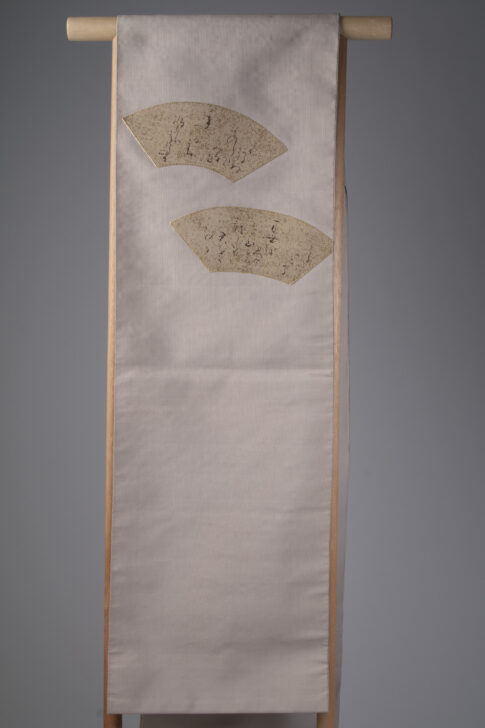Saga brocade obi with woven designs of poetry-inscribed fans
Japanese

Description
Gallery Rotation Fall 2013
Obi
Japan, Showa period (1926–1989)
1940s–50s
Silk with appliquéd Saga brocade patches
Gift of Howard and Patricia Yamaguchi, 2005/1.335
This pink-grey obi is embellished with fan-shaped pieces of Saga brocade. Although the majority of Japanese brocade—a rich fabric with a raised design, woven with gold and silver threads—is produced in the Nishijin district of Kyoto, certain brocades are made in former castle towns like Saga and Kaga. Saga brocade, still renowned today, originated as a textile art practiced as a pastime in the Edo period (1615–1868) by the ladies-in-waiting of the ruling Nabeshima clan of the Kashima domain (modern-day Saga prefecture in the southwestern island of Kyûshû). It is hand produced on a small, lap-sized table using thin gold, silver, and platinum papers for the warp, and colorful silk threads for the weft. Because of the delicate, painstaking nature of the process, only a tiny amount can be woven in one day. Saga brocade, therefore, is usually restricted to appliqués, as it is here. The poems on these pieces of brocade were specially commissioned from a professional calligrapher. They allude to a long tradition of applying calligraphy directly to kimono during the Edo period.
Subject Matter:
Saga brocade obi with woven poetry inscribed fan designs.
Physical Description:
Light mauve silk with appliqued Saga brocade patches of gold fans with calligraphic poetry on them. The calligraphy has been brushed on paper with gold flecks (sunago). which is the weft of the Saga brocade; brown silk thread is the warp. Partially backed with a different silk, a taupe with deliberately knotted weft; reamainder backed with plain-weave taupe silk.
Usage Rights:
If you are interested in using an image for a publication, please visit https://umma.umich.edu/request-image/ for more information and to fill out the online Image Rights and Reproductions Request Form.